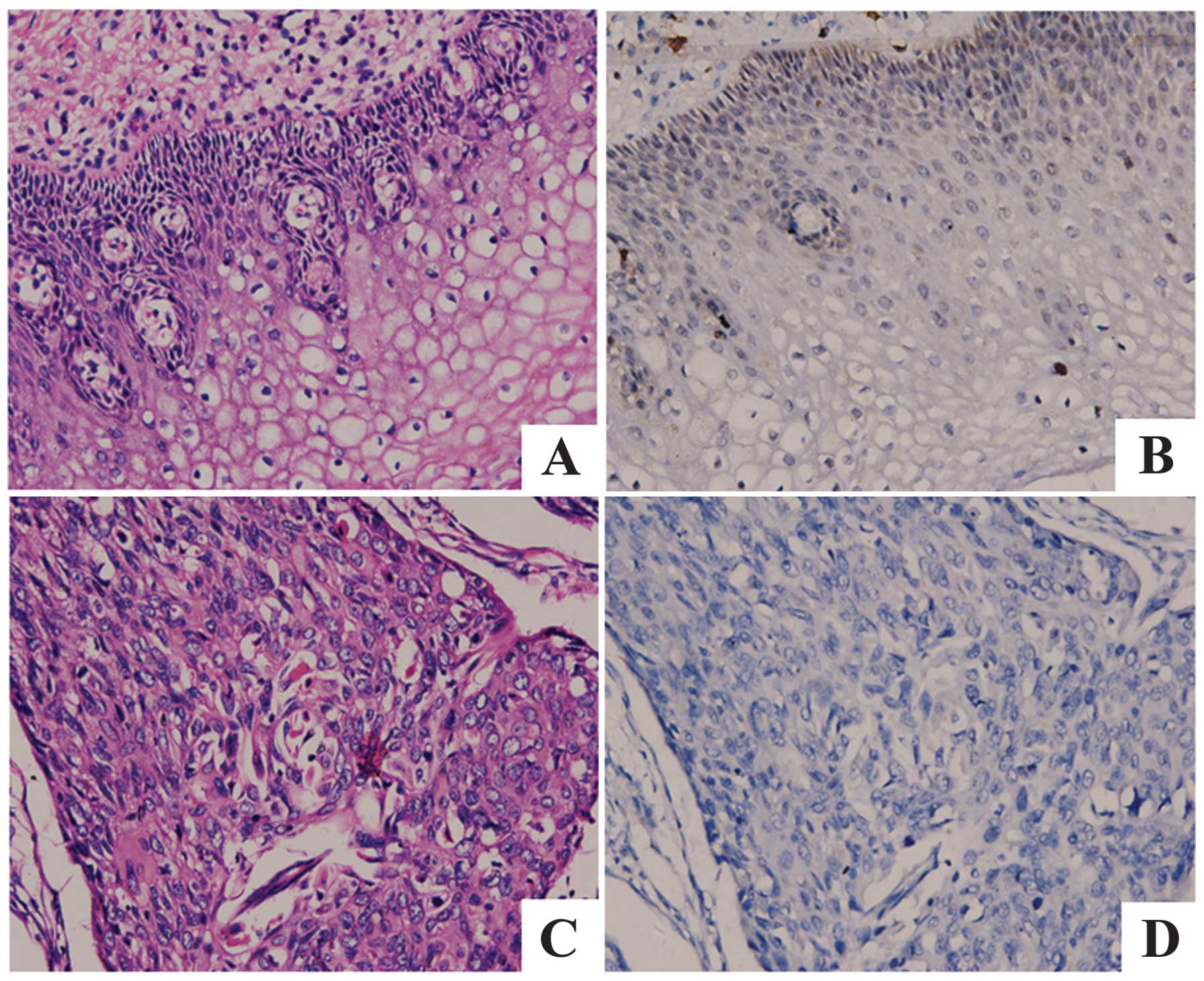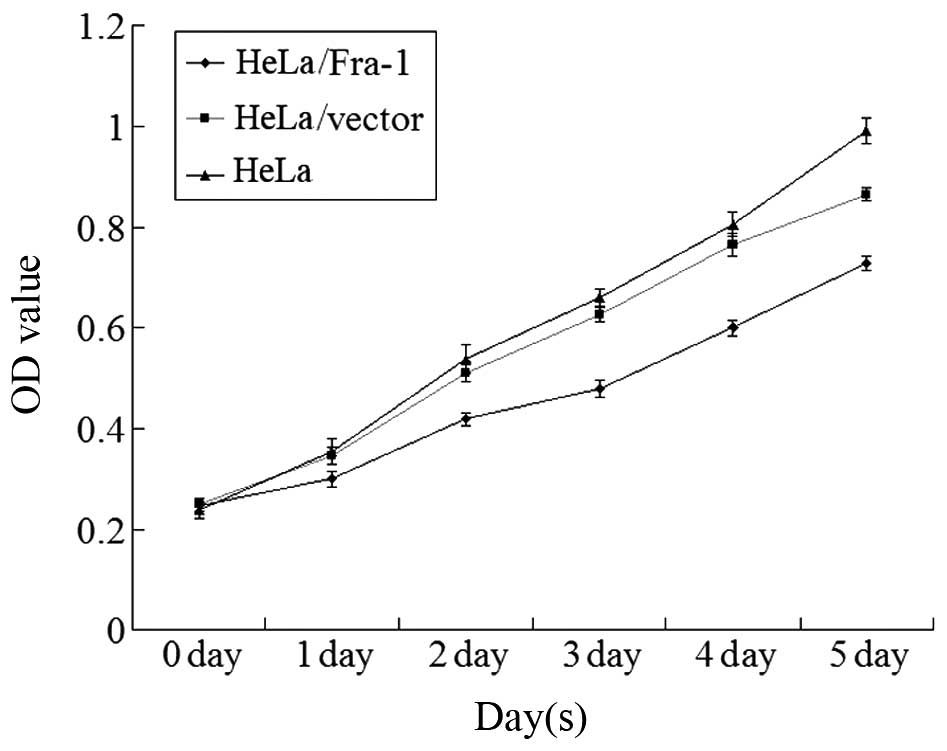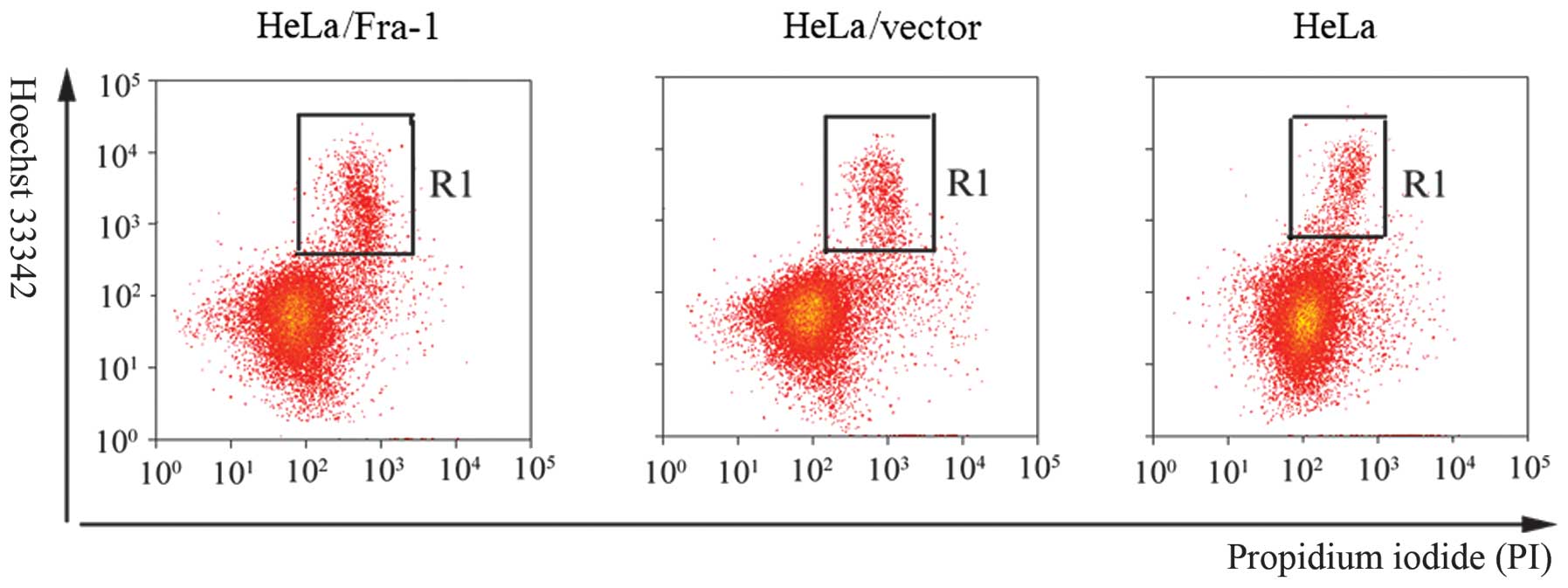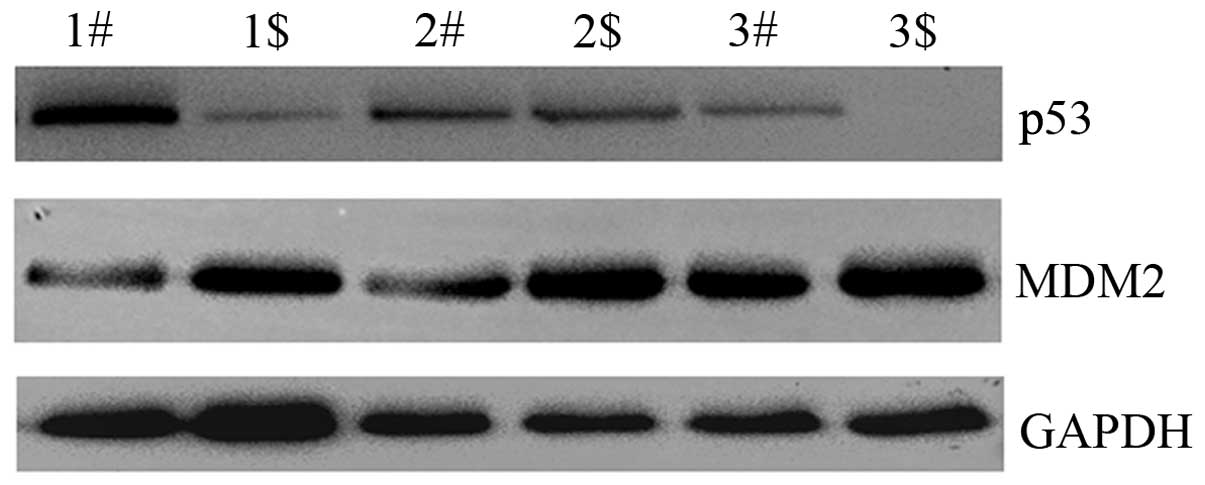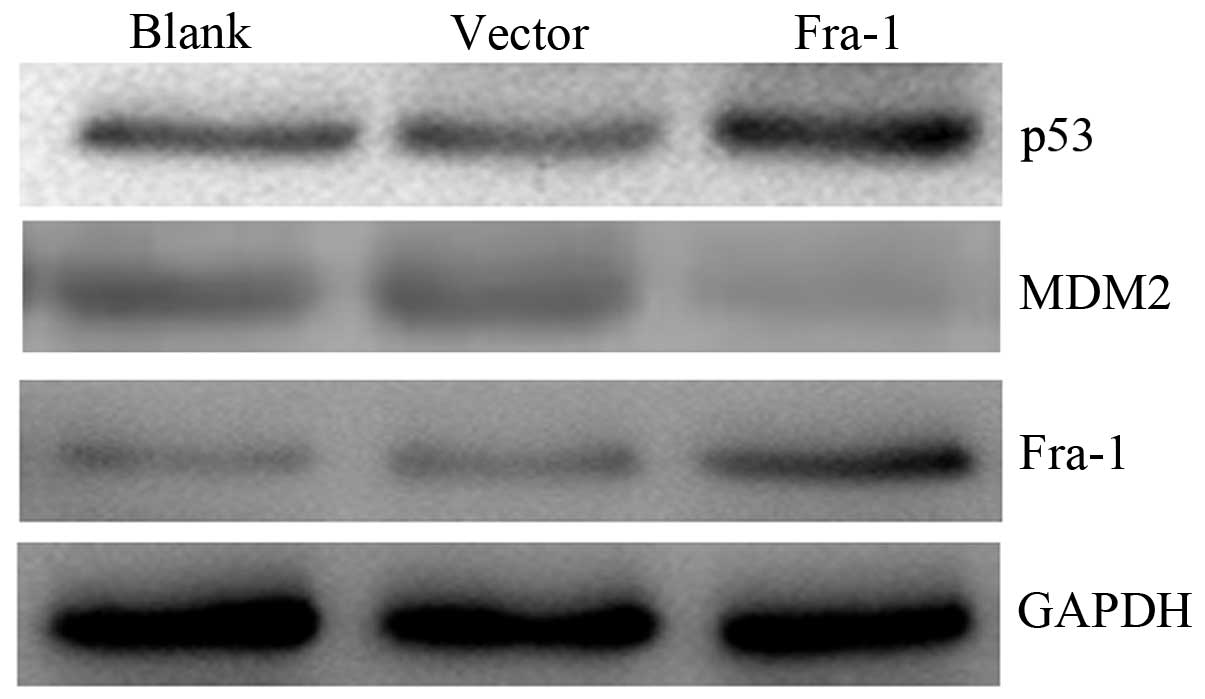Fra‑1 is downregulated in cervical cancer tissues and promotes cervical cancer cell apoptosis by p53 signaling pathway in vitro
- Authors:
- Published online on: February 4, 2015 https://doi.org/10.3892/ijo.2015.2873
- Pages: 1677-1684
Abstract
Introduction
Cervical cancer is a potentially preventable disease; however, it is the third most commonly diagnosed cancer and the fourth leading cause of cancer deaths in women worldwide, accounting for 9% (529,800) of the new cancer cases and 8% (275,100) of the cancer deaths among women in 2008 (1–3). More than 85% of these cases and deaths occur in developing countries, including China (1–3). Cervical cancer is thought to develop through a multistep process involving virus, tumor suppressor genes, proto-oncogenes and immunological factors (4,5). It is known that human papillomavirus (HPV) infection is necessary, but insufficient to cause malignancy indicating the importance of other factors for malignant conversion of high-grade HPV infection (6–9). Key events that drive cancer are influenced by a multitude of factors that still remain to be understood (10–12). The etiology of cervical carcinoma remains poorly understood.
The FOS-like antigen-1 (Fra-1) is a member of the FOS transcription factor family playing important roles in transformation, proliferation, and metastasis (13–18). Fra-1 is extensively phosphorylated in response to serum mitogens or insulin in normal cell types, or in response to oncogenic RAS in transformed thyroid lines (19–22). In addition, the extent of Fra-1 phosphorylation is cell cycle regulated, being further increased in the G2/M cell fraction (13,23–25). The results obtained from various studies show different implications for Fra-1 according to tumor type. Fra-1 overexpression is predominantly associated with a large variety of epithelial tumors, including thyroid, breast, lung, brain, nasopharyngeal, esophageal, endometrial, prostate and colon carcinomas, along with glioblastomas and mesotheliomas (26,27). Fra-1 is downregulated in the tumorigenic cell lines CGL3 and HeLa compared to the non-tumorigenic 444 cells. It inhibits the tumorigenicity of cervical carcinoma cell lines (28). Fra-1 has tumor-suppressing function upon micro-cell transfer in HPV-16- and HPV-18-positive cervical carcinoma cells (29). Thus, it is urgent to explore the relationship between Fra-1 and cervical carcinoma.
Tumor suppressor p53 is the central component of a system maintaining the genetic stability of animal and human somatic cells (30–33). One of the important functions of p53 is to recognize when DNA damage has occurred in a cell and arrest the growth of that cell in the G1 period of the cell cycle to allow for DNA repair or, if repair is not possible, to lead that cell into cell-mediated death or suicide, called apoptosis (32–35). The p53 gene plays the key role in maintaining the genetic homogeneity of somatic cells and is most often affected in cancer (32–37).
We examined the expression levels of Fra-1 and the key molecules of p53 signaling pathway in cervical cancer tissues. At the same time, the effects and possible mechanism of Fra-1 were studied in a cervical cancer cell line.
Materials and methods
Cell culture
A human HeLa cervical cancer cell line was cultured in DMEM supplemented with 10% fetal bovine serum (FBS) (Gibco by Life Technologies™, Grand Island, NY, USA), 100 U/ml penicillin and 100 μg/ml streptomycin at 37°C in the presence of 5% CO2.
Tumor samples
Twenty participants were recruited at the Third Xiangya Hospital, Central South Uuniversity (Hunan, China). Consent forms were obtained from individual patients, and experimental protocols were approved by the Institutional Review Board of the Third Xiangya Hospital. At the Third Xiangya Hospital, 20 participants were women with histologically confirmed cervical cancer (Table I). All subjects enrolled in the study were Chinese. Cervical cancer tissue and corresponding non-tumor normal tissue were collected, and each biopsy sample was divided into two sections, one was submitted to routine histological diagnosis, and the remaining section was evaluated by qPCR and western blotting.
RNA extraction and quantitative real-time PCR
Total RNA was extracted from the biopsy samples with RNeasy® kit (Qiagen, Carlsbad, CA, USA) according to the manufacture’s instructions. The total RNA sample (1 μg) was used to generate cDNA. Reverse transcription was carried out as described previously (38–42). After the RT reaction, the PCR reaction was preceded by 94°C for 5 min, then 30 cycles for Fra-1 of 94°C for 45 sec, 55°C for 45 sec, and 72°C for 1 min followed by 72°C for 7 min. All RT-PCR reactions were repeated at least three times at different number of extension cycles to avoid false results of the PCR. Glyceraldehyde 3-phosphate dehydrogenase (GAPDH) was used as an endogenous control for normalization. The sequences of the primers used for RT-PCR were as follows: Fra-1 forward, 5′-cgaaggccttgtgaacagat-3′ and reverse, 5′-cttctgcttctgcagctcct-3′; GAPDH forward, 5′-cgaccactttgtcaagctca-3′ and reverse, 5′-actgagtgtggcagggactc-3′. Expression of mRNA was assessed by evaluating cycle threshold (CT) values. The CT values were normalized with the expression levels of GAPDH and the relative amount of mRNA specific to each of the target genes was calculated using the 2−ΔΔCT method (42,43).
Immunohistochemistry (IHC) and evaluation of staining
IHC was done using the peroxidase-anti-peroxidase technique following a microwave antigen retrieval procedure. Antibody for Fra-1 was purchased from ImmunoWay Biotechnology Co. (Newark, DE, USA). Antibody against Fra-1 (1:100) was overlaid on cervical cancer and corresponding non-tumor normal tissue sections and incubated overnight at 4°C. Secondary antibody incubation (Santa Cruz Biotechnology, Inc., Santa Cruz, CA, USA) was performed at room temperature for 30 min.
Sections were blindly evaluated by two investigators in an effort to provide a consensus on staining patterns by light microscopy (Olympus, Tokyo, Japan). Fra-1 staining was assessed according to the methods described by Hara and Okayasu (44) with minor modifications. Each case was rated according to a score that added a scale of intensity of staining to the area of staining. At least 10 high-power fields were chosen randomly, and >1,000 cells were counted for each section. The intensity of staining was graded on the following scale: 0, no staining; 1+, mild staining; 2+, moderate staining; 3+, intense staining. The area of staining was evaluated as follows: 0, no staining of cells in any microscopic fields; 1+, <30% of tissue stained positive; 2+, 30–60% stained positive; 3+, >60% stained positive. The minimum score when summed (extension + intensity) was, therefore, 0, and the maximum, 6. A combined staining score (extension + intensity) of ≤ 2 was considered to be a negative staining (low staining); 3–4, a moderate staining; and 5–6, a strong staining.
Construction of pEGFP-N1-Fra-1 vector and cell transfection
The pEGFP-N1-Fra-1 plasmid constructed to target Fra-1 (RefSeq ID: NM_001300844.1) was obtained from Shanghai Genechem Co., Ltd. (Shanghai, China). pEGFP-N1 plasmid (Shanghai Genechem Co., Ltd.) was cut with EcoRI/BamHI and ligated by T4 DNA ligase with gene encoding Fra-1, making the Fra-1-pEGFP construct. The fusion sequences were verified by DNA sequencing using ABI 3730. The empty pEGFP-N1 vector was used as a negative control.
To establish a stable Fra-1-expressing cell line, the plasmid pEGFP-N1/Fra-1 or control empty vector pEGFP-N1 was transfected into HeLa cells, using Lipofectamine (Invitrogen Life Technologies, Carlsbad, CA, USA) according to the manufacturer’s instructions, followed by G418 selection. The stable transfectants, HeLa/Fra-1 and HeLa/vector, were isolated and the transcription of Fra-1 protein was determined by western blot experiments.
Cell proliferation assay
The impact of Fra-1 on HeLa cell proliferation was measured by MTT assay as described previously (34). Briefly, HeLa cells (HeLa, HeLa/vector, and HeLa/Fra-1 cells) (104 cells/well) were cultured in triplicate with 10% FCS DMEM in 96-well plates, respectively. The cells were then exposed to 5 mg/ml MTT for 4 h. The generated formazan was dissolved with dimethyl sulfoxide and measured at 570 nm using an ELx800 Microplate Reader (BioTek Instruments, Inc., Winooski, VT, USA).
The effect of Fra-1 to cervical cancer cell apoptosis
Cell apoptosis was analyzed by flow cytometry analysis using a MoFlo™ XDP High-Performance Cell Sorter (Beckman Coulter, Miami, FL, USA) PI and Hoechst 33342 double staining (Nanjing KeyGen Biotech., Co., Ltd., Jiangsu, China). Briefly, HeLa cells (HeLa, HeLa/vector, and HeLa/Fra-1 cells) were seeded at a density of 3×105 cells/well in 24-well culture plates. Cells were collected in an Eppendorf tube 24 h and washed twice with PBS by centrifugation. The supernatants were discarded. To detect apoptosis, 500 μl PBS, 5 μl Hoechst 33342 and 5 μl PI were added to each tube, and the contents of the tube were mixed in the dark, at room temperature for 15 min, followed by FCM testing. The data acquired were analyzed with Summit v5.2 software.
Western blotting
Proteins of the biopsy samples were prepared by lysis buffer. The protein concentrations were determined using the Bicinchoninic Acid Protein Assay method (Pierce Biotechnology, Rockford, IL, USA). Extracts containing 50 μg of proteins were separated in 10% SDS-PAGE gels and electroblotted onto nitrocellulose membrances (HyClone Laboratories, Inc., Logan, UT, USA). The membranes were blocked using Tris-buffered saline/Tween-20 (25 mM Tris-HCl, 150 mM NaCl, pH 7.5, and 0.05% Tween-20) containing 5% non-fat milk followed by overnight incubation at 4°C with primary antibodies (rabbit anti-Fra-1 antibody, 1:300, ImmunoWay Biotechnology Co.; rabbit anti-MDM2 antibody, 1:200, and rabbit anti-p53 antibody, 1:200, Wuhan Boster Biological Technology, Ltd., Hubei, China). After three washes, secondary antibodies (anti-horseradish peroxidase antibodies, 1:2,000; Santa Cruz Biotechnology, Inc.) were added, and incubated for 1 h. Then anti-GAPDH antibody (1:3,000; Santa Cruz Biotechnology, Inc.) was used as a loading control.
Statistical analysis
Differences of non-parametric variables were analyzed by the Fisher’s exact test using EPI software (EPI Info, version 3.2.2, www.CDC.gov/epiinfo/). Differences of the quantitative variables between groups were analyzed by Student’s t-test using SPSS 13.0 program (SPSS, Inc., Chicago, IL, USA). P<0.05 was considered statistically significant.
Results
Detection of mRNA expression levels of Fra-1 gene in cervical cancer
To detect the mRNA expression levels of Fra-1 gene in cervical cancer and the adjacent non-cancerous tissues, we chose 20 cervical cancer tissues and the adjacent non-cancerous tissues to perform real-time quantitative RT-PCR of Fra-1 genes. Sample spreadsheet of data analysis was constructed by the 2−ΔΔCT method. The fold change in the expression of the Fra-1 gene relative to the internal control gene (GAPDH) was studied. The expression of Fra-1 gene was downregulated in cervical cancer (Table II). Compared with the control samples, the normalized Fra-1 gene expression in cervical cancer was 0.32 times, 95% confidence interval (CI) was 0.22–0.48.
Table IIIdentification of the mRNA expression level of Fra-1 in cervical cancer and adjacent non-cancerous tissues by qPCR. |
IHC analysis of protein expression levels of Fra-1 in cervical cancer
IHC was carried out with antibodies against Fra-1 protein in cervical cancer and the adjacent non-cancerous tissues. Fra-1 was identified as differentially expressed between cervical cancer tissues versus the adjacent non-cancerous tissues. IHC showed a similar pattern in protein expression with RT-qPCR results. There was 10.0% (2/10) high score of Fra-1 in cervical cancer tissues and 45% (9/20) in the adjacent non-cancerous tissues. The distribution of low score was 65.0% (13/20) and 15.0% (3/20) in cervical cancer and the adjacent non-cancerous tissues, respectively (p=0.004 <0.05) (Fig. 1 and Table III).
Table IIIThe difference of Fra-1 expression between cervical cancer and the adjacent non-cancerous tissues. |
Analysis of protein expression levels of Fra-1 in cervical cancer by western blotting
To determine whether the Fra-1 had lower expression level in cervical cancer than the adjacent non-cancerous tissues, we further examined the protein expression levels of Fra-1 in cervical cancer and the adjacent non-cancerous tissues by western blotting. In comparison with the control, the expression level was low in cervical cancer tissues (Fig. 2). It corresponded to the results of RT-qPCR and IHC. It confirmed that Fra-1 expression is low in cervical cancer.
Fra-1 inhibits the growth of cervical cancer cells in vitro
To elucidate the function of Fra-1 in the growth of cervical cancer cells, the HeLa cells were transfected with the plasmid pEGFP-N1/Fra-1 or control vector to generate Fra-1-stable expressing HeLa/Fra-1, control HeLa/vector cell lines. After demonstrating Fra-1 protein by western blotting, the spontaneous proliferation of HeLa, HeLa/vector, and HeLa/Fra-1 cells was determined by the MTT assays, respectively. Clearly, Fra-1 significantly inhibited the proliferation of HeLa cells (Fig. 3). Therefore, endogenous Fra-1 overexpression inhibited the proliferation of cervical cancer cells in vitro.
Fra-1 induces cervical cancer cell apoptosis
Inhibition of cell proliferation usually is mediated by inducing cell apoptosis. To determine whether apoptosis mediated the growth in HeLa, HeLa/vector, and HeLa/Fra-1 cells, we performed a Hoechst 33342/PI double staining experiment. A considerable increase in apoptotic cells was observed for HeLa/Fra-1 cells (15.36±0.48%), HeLa cells (8.97±0.91%), and HeLa/vector cells (9.22±0.85%) (Fig. 4).
Fra-1 is correlated with dysregulation of p53 signaling pathway in cervical cancer tissues in vitro
To uncover the possible mechanism of Fra-1 in cervical cancer, we tested the expression levels of key molecules in p53 signaling pathway by western blotting technology. p53 was downregulated in cervical cancer compared with the adjacent non-cancerous tissues, whereas, MDM2 proto-oncogene, E3 ubiquitin protein ligase (MDM2) was upregulated in cervical cancer (Fig. 5). Combined with the above result showing low Fra-1 expression in cervical cancer, we inferred that Fra-1 is correlated with dysregulation of p53 signaling pathway in cervical cancer tissues in vitro.
Fra-1 overexpression affects the expression of p53 and MDM2 in vivo
To confirm whether Fra-1 affects the expression of p53 and MDM2 in vivo, the HeLa cells were transfected with the plasmid pEGFP-N1/Fra-1 or control vector to generate Fra-1-stable expressing HeLa/Fra-1, control HeLa/vector cell lines. We harvested the cells and tested the expression levels of p53 and MDM2 proteins in vivo. The p53 was upregulated in HeLa cells with Fra-1 overexpression, but MDM2 was downregulated (Fig. 6). Our results suggested that Fra-1 overexpression affected the expression of p53 and MDM2 in vivo.
Discussion
Cervical cancer that has been proven to be associated with HPV is the second most common cancer in women worldwide and is a leading cause of cancer deaths in women in developing countries (45,46). Therefore, it is necessary and urgent to study the etiology of cervical cancer.
In this study, we chose 20 cervical cancer tissues and the adjacent non-cancerous tissues to perform real-time quantitative RT-PCR of Fra-1 gene. The results showed that the expression of Fra-1 gene was downregulated in cervical cancer. The normalized Fra-1 gene expression in cervical cancer was 0.32-fold compared with the control samples. Results of IHC and western blotting showed a similar pattern in protein expression with RT-qPCR results. Thus, we confirmed low Fra-1 expression in cervical cancer tissues. Kehrmann et al found that Fra-1 was downregulated in the tumorigenic cell lines CGL3 and HeLa compared to the non-tumorigenic 444 cells (28). The results of Soto et al showed that Fra-1 has tumor-suppressing function upon micro-cell transfer in HPV-16- and HPV-18-positive cervical-carcinoma cells (29). Our data are consistent with the above observations and suggest that Fra-1 may play an important role in cervical cancer.
To elucidate the function of Fra-1 in the growth of cervical cancer cells, our results showed that Fra-1 significantly inhibited the proliferation of HeLa cells by MTT assay. Inhibition of cell proliferation is usually mediated by inducing cell apoptosis. Therefore, we tested apoptosis of Fra-1 overexpression in HeLa cell lines and a considerable increase in apoptotic cells was observed. Our data suggested that Fra-1 may affect the proliferation of cervical cancer cells by mediated cell apoptosis. Song et al found that Irisin promoted human umbilical vein endothelial cell proliferation by partly suppressing cell apoptosis (47). Yang et al confirmed that downregulation of SIRT3 expression affected the proliferation and apoptosis in esophageal squamous cell carcinoma EC9706 cells (48). Above all, Fra-1 can affect proliferation and apoptosis of HeLa cells.
To uncover the possible mechanism of Fra-1 in cervical cancer, we detected the expression levels of p53 and MDM2 in cervical cancer tissues and in HeLa cells with Fra-1 overexpression by western blotting technology. We found that p53 was downregulated and MDM2 was upregulated in cervical cancer compared with the adjacent non-cancerous tissues, whereas, the p53 was upregulated and MDM2 was downregulated in HeLa cells with Fra-1 overexpression. Degradation of p53 is regulated by its interaction with specific E3 ubiquitin ligases, the best known one being encoded by MDM2 (49). A greater increase in p53 content and activation of p53 via additional modification occur when the cell is exposed to various stress factors, such as irradiation or DNA damage (50). Damage to p53-dependent mechanism is often caused by overexpression of MDM2, which codes for a p53-regulating protein (51). Combined with the above result where Fra-1 expression was low in cervical cancer, we inferred Fra-1 was correlated with dysregulation of p53 signaling pathway in cervical cancer tissues in vitro and Fra-1 overexpression affected the expression of p53 and MDM2 in vivo.
In summary, our results showed that Fra-1 expression was low in cervical carcinoma tissues and it plays an important role in dysregulation of the p53 signaling pathway.
Acknowledgements
This study was supported by the National Natural Science Foundation of China (81272975, 81402270); Key Project of Hunan Provincial Natural Science Foundation (12JJ2044); the Key Planned Science and Technology Project of Hunan Province (2012FJ2014); the Planned Science and Technology Project of Hunan Province (2011FJ3153); the Planned Project of Development and Reform Commission of Hunan Province (2012-1493-1); the Planned Project of Department of Health of Hunan Province (B2011-030, B2012-029); the Planned Project of Key Subject Construction of the Third Xiangya Hospital, Central South University; the Open-End Fund for the Valuable and Precision Instruments of Central South University.
Abbreviations:
|
Fra-1 |
FOS-like antigen-1 |
|
GAPDH |
glyceraldehyde 3-phosphate dehydrogenase |
|
HPV |
human papillomavirus |
|
MDM2 |
MDM2 proto-oncogene, E3 ubiquitin protein ligase |
|
TP53 |
tumor protein p53 |
|
CI |
confidence interval |
|
IHC |
immunohistochemistry |
References
|
Jemal A, Bray F, Center MM, Ferlay J, Ward E and Forman D: Global cancer statistics. CA Cancer J Clin. 61:69–90. 2011. View Article : Google Scholar : PubMed/NCBI | |
|
Boutas I, Sofoudis C, Kalampokas E, Anastasopoulos C, Kalampokas T and Salakos N: Fertility preservation in women with early stage cervical cancer. Review of the literature. Eur J Gynaecol Oncol. 35:373–377. 2014.PubMed/NCBI | |
|
He L, Wu L, Su G, Wei W, Liang L, Han L, Kebria M, Liu P, Chen C, Yu Y, Zhong M and Wang W: The efficacy of neoadjuvant chemotherapy in different histological types of cervical cancer. Gynecol Oncol. 134:419–425. 2014. View Article : Google Scholar : PubMed/NCBI | |
|
Georgieva S, Iordanov V and Sergieva S: Nature of cervical cancer and other HPV-associated cancers. J BUON. 14:391–398. 2009.PubMed/NCBI | |
|
Lazcano-Ponce E and Allen-Leigh B: Innovation in cervical cancer prevention and control in Mexico. Arch Med Res. 40:486–492. 2009. View Article : Google Scholar : PubMed/NCBI | |
|
Boshart M, Gissmann L, Ikenberg H, Kleinheinz A, Scheurlen W and zur Hausen H: A new type of papillomavirus DNA, its presence in genital cancer biopsies and in cell lines derived from cervical cancer. EMBO J. 3:1151–1157. 1984.PubMed/NCBI | |
|
Dürst M, Gissmann L, Ikenberg H and zur Hausen H: A papillomavirus DNA from a cervical carcinoma and its prevalence in cancer biopsy samples from different geographic regions. Proc Natl Acad Sci USA. 80:3812–3815. 1983. View Article : Google Scholar : PubMed/NCBI | |
|
Cheng JX, Yuan M, Li AL, Zhou P, Shen GQ and Zhang Y: Quantitative analysis of P16 gene CpG methylation in Uyghur patients with cervical squamous cell carcinoma and its relationship with HPV16 infection. Genet Mol Res. 13:7428–7436. 2014. View Article : Google Scholar : PubMed/NCBI | |
|
Andersson S, Mints M, Gyllensten U, Lindell M, Gustavsson I, Lambe M and Wilander E: Uneven distribution of human papillomavirus 16 in cervical carcinoma in situ and squamous cell carcinoma in older females: A retrospective database study. Oncol Lett. 8:1528–1532. 2014.PubMed/NCBI | |
|
McLaughlin-Drubin ME and Munger K: Viruses associated with human cancer. Biochim Biophys Acta. 1782:127–150. 2008. View Article : Google Scholar : PubMed/NCBI | |
|
Deivendran S, Marzook KH and Radhakrishna Pillai M: The role of inflammation in cervical cancer. Adv Exp Med Biol. 816:377–399. 2014. View Article : Google Scholar : PubMed/NCBI | |
|
Ramdass B, Chowdhari A and Koka P: Cancer-initiating cells as target for prevention of recurring disease etiology: role of these malignant putative progenitor cells in relapse or metastasis of human cervical carcinoma. J Stem Cells. 8:233–251. 2013. | |
|
Luo Y, Zhou H, Mizutani M, Mizutani N, Reisfeld RA and Xiang R: Transcription factor Fos-related antigen 1 is an effective target for a breast cancer vaccine. Proc Natl Acad Sci USA. 100:8850–8855. 2003. View Article : Google Scholar : PubMed/NCBI | |
|
Luo Y, Zhou H, Mizutani M, Mizutani N, Liu C, Xiang R and Reisfeld RA: A DNA vaccine targeting Fos-related antigen 1 enhanced by IL-18 induces long-lived T-cell memory against tumor recurrence. Cancer Res. 65:3419–3427. 2005.PubMed/NCBI | |
|
Cohen DR and Curran T: fra-1: a serum-inducible, cellular immediate-early gene that encodes a fos-related antigen. Mol Cell Biol. 8:2063–2069. 1988.PubMed/NCBI | |
|
Schreiber M, Poirier C, Franchi A, Kurzbauer R, Guenet JL, Carle GF and Wagner EF: Structure and chromosomal assignment of the mouse fra-1 gene, and its exclusion as a candidate gene for oc (osteosclerosis). Oncogene. 15:1171–1178. 1997. View Article : Google Scholar : PubMed/NCBI | |
|
Desmet CJ, Gallenne T, Prieur A, Reyal F, Visser NL, Wittner BS, Smit MA, Geiger TR, Laoukili J, Iskit S, Rodenko B, Zwart W, Evers B, Horlings H, Ajouaou A, Zevenhoven J, van Vliet M, Ramaswamy S, Wessels LF and Peeper DS: Identification of a pharmacologically tractable Fra-1/ADORA2B axis promoting breast cancer metastasis. Proc Natl Acad Sci USA. 110:5139–5144. 2013. View Article : Google Scholar : PubMed/NCBI | |
|
Lu D, Chen S, Tan X, Li N, Liu C, Li Z, Liu Z, Stupack DG, Reisfeld RA and Xiang R: Fra-1 promotes breast cancer chemo-sensitivity by driving cancer stem cells from dormancy. Cancer Res. 72:3451–3456. 2012. View Article : Google Scholar : PubMed/NCBI | |
|
Casalino L, De Cesare D and Verde P: Accumulation of Fra-1 in ras-transformed cells depends on both transcriptional autoregulation and MEK-dependent posttranslational stabilization. Mol Cell Biol. 23:4401–4415. 2003. View Article : Google Scholar : PubMed/NCBI | |
|
Zippo A, De Robertis A, Serafini R and Oliviero S: PIM1-dependent phosphorylation of histone H3 at serine 10 is required for MYC-dependent transcriptional activation and oncogenic transformation. Nat Cell Biol. 9:932–944. 2007. View Article : Google Scholar : PubMed/NCBI | |
|
Casalino L, Bakiri L, Talotta F, Weitzman JB, Fusco A, Yaniv M and Verde P: Fra-1 promotes growth and survival in RAS-transformed thyroid cells by controlling cyclin A transcription. EMBO J. 26:1878–1890. 2007. View Article : Google Scholar : PubMed/NCBI | |
|
Adiseshaiah P, Papaiahgari SR, Vuong H, Kalvakolanu DV and Reddy SP: Multiple cis-elements mediate the transcriptional activation of human fra-1 by 12-O-tetradecanoylphorbol-13-acetate in bronchial epithelial cells. J Biol Chem. 278:47423–47433. 2003. View Article : Google Scholar : PubMed/NCBI | |
|
Adiseshaiah P, Peddakama S, Zhang Q, Kalvakolanu DV and Reddy SP: Mitogen regulated induction of FRA-1 proto-oncogene is controlled by the transcription factors binding to both serum and TPA response elements. Oncogene. 24:4193–4205. 2005. View Article : Google Scholar : PubMed/NCBI | |
|
Gruda MC, Kovary K, Metz R and Bravo R: Regulation of Fra-1 and Fra-2 phosphorylation differs during the cell cycle of fibroblasts and phosphorylation in vitro by MAP kinase affects DNA binding activity. Oncogene. 9:2537–2547. 1994.PubMed/NCBI | |
|
Hurd TW, Culbert AA, Webster KJ and Tavaré JM: Dual role for mitogen-activated protein kinase (Erk) in insulin-dependent regulation of Fra-1 (fos-related antigen-1) transcription and phosphorylation. Biochem J. 368:573–580. 2002. View Article : Google Scholar : PubMed/NCBI | |
|
Milde-Langosch K: The Fos family of transcription factors and their role in tumourigenesis. Eur J Cancer. 41:2449–2461. 2005. View Article : Google Scholar : PubMed/NCBI | |
|
Belguise K, Milord S, Galtier F, Moquet-Torcy G, Piechaczyk M and Chalbos D: The PKCθ pathway participates in the aberrant accumulation of Fra-1 protein in invasive ER-negative breast cancer cells. Oncogene. 31:4889–4897. 2012. View Article : Google Scholar : PubMed/NCBI | |
|
Kehrmann A, Truong H, Repenning A, Boger R, Klein-Hitpass L, Pascheberg U, Beckmann A, Opalka B and Kleine-Lowinski K: Complementation of non-tumorigenicity of HPV18-positive cervical carcinoma cells involves differential mRNA expression of cellular genes including potential tumor suppressor genes on chromosome 11q13. Cancer Genet. 206:279–292. 2013. View Article : Google Scholar : PubMed/NCBI | |
|
Soto U, Denk C, Finzer P, Hutter KJ, zur Hausen H and Rösl F: Genetic complementation to non-tumorigenicity in cervical-carcinoma cells correlates with alterations in AP-1 composition. Int J Cancer. 86:811–817. 2000. View Article : Google Scholar : PubMed/NCBI | |
|
Missero C and Antonini D: Crosstalk among p53 family members in cutaneous carcinoma. Exp Dermatol. 23:143–146. 2014. View Article : Google Scholar : PubMed/NCBI | |
|
Bertheau P, Lehmann-Che J, Varna M, Dumay A, Poirot B, Porcher R, Turpin E, Plassa LF, de Roquancourt A, Bourstyn E, de Cremoux P, Janin A, Giacchetti S, Espié M and de Thé H: p53 in breast cancer subtypes and new insights into response to chemotherapy. Breast. 22(Suppl 2): S27–S29. 2013. View Article : Google Scholar : PubMed/NCBI | |
|
Tassone P, Old M, Teknos TN and Pan Q: p53-based therapeutics for head and neck squamous cell carcinoma. Oral Oncol. 49:733–737. 2013. View Article : Google Scholar : PubMed/NCBI | |
|
Ku JH, Byun SS, Jeong H, Kwak C, Kim HH and Lee SE: The role of p53 on survival of upper urinary tract urothelial carcinoma: a systematic review and meta-analysis. Clin Genitourin Cancer. 11:221–228. 2013. View Article : Google Scholar : PubMed/NCBI | |
|
Tornesello ML, Buonaguro L and Buonaguro FM: Mutations of the TP53 gene in adenocarcinoma and squamous cell carcinoma of the cervix: a systematic review. Gynecol Oncol. 128:442–448. 2013. View Article : Google Scholar | |
|
Liu J, Ma Q, Zhang M, Wang X, Zhang D, Li W, Wang F and Wu E: Alterations of TP53 are associated with a poor outcome for patients with hepatocellular carcinoma: evidence from a systematic review and meta-analysis. Eur J Cancer. 48:2328–2338. 2012. View Article : Google Scholar : PubMed/NCBI | |
|
Mitchell S, Mayer E and Patel A: Expression of p53 in upper urinary tract urothelial carcinoma. Nat Rev Urol. 8:516–522. 2011. View Article : Google Scholar : PubMed/NCBI | |
|
Nayak SK, Panesar PS and Kumar H: Non-genotoxic p53-activators and their significance as antitumor therapy of future. Curr Med Chem. 18:1038–1049. 2011. View Article : Google Scholar : PubMed/NCBI | |
|
Xiao S, Zhou Y, Jiang J, Yuan L and Xue M: CD44 affects the expression level of FOS-like antigen 1 in cervical cancer tissues. Mol Med Rep. 9:1667–1674. 2014.PubMed/NCBI | |
|
Liao S, Xiao S, Zhu G, Zheng D, He J, Pei Z, Li G and Zhou Y: CD38 is highly expressed and affects the PI3K/Akt signaling pathway in cervical cancer. Oncol Rep. 32:2703–2709. 2014.PubMed/NCBI | |
|
Zhu W, Li J, Su J, Li J, Li J, Deng B, Shi Q, Zhou Y and Chen X: FOS-like antigen 1 is highly expressed in human psoriasis tissues and promotes the growth of HaCaT cells in vitro. Mol Med Rep. 10:2489–2494. 2014.PubMed/NCBI | |
|
Xiao S, Liao S, Zhou Y, Jiang B, Li Y and Xue M: High expression of octamer transcription factor 1 in cervical cancer. Oncol Lett. 7:1889–1894. 2014.PubMed/NCBI | |
|
Zhou Y, Wang W, Zheng D, Peng S, Xiong W, Ma J, Zeng Z, Wu M, Zhou M, Xiang J, Xiang B, Li X, Li X and Li G: Risk of nasopharyngeal carcinoma associated with polymorphic lacto-transferrin haplotypes. Med Oncol. 29:1456–1462. 2012. View Article : Google Scholar | |
|
Livak KJ and Schmittgen TD: Analysis of relative gene expression data using real-time quantitative PCR and the 2(−Delta Delta C(T)) method. Methods. 25:402–408. 2001. View Article : Google Scholar | |
|
Hara A and Okayasu I: Cyclooxygenase-2 and inducible nitric oxide synthase expression in human astrocytic gliomas: correlation with angiogenesis and prognostic significance. Acta Neuropathol. 108:43–48. 2004. View Article : Google Scholar : PubMed/NCBI | |
|
Salehi M, Taheri T, Mohit E, Zahedifard F, Seyed N, Taslimi Y, Sattari M, Bolhassani A and Rafati S: Recombinant Leishmania tarentolae encoding the HPV type 16 E7 gene in tumor mice model. Immunotherapy. 4:1107–1120. 2012. View Article : Google Scholar : PubMed/NCBI | |
|
Sahiner F, Gümral R, Sener K, Yiğit N, Dede M, Yapar M and Kubar A: Investigation of HPV-DNA in cervical smear samples by two different methods: MY09/11 consensus PCR and type-specific real-time PCR. Mikrobiyol Bul. 46:624–636. 2012.(In Turkish). PubMed/NCBI | |
|
Song H, Wu F, Zhang Y, Zhang Y, Wang F, Jiang M, Wang Z, Zhang M, Li S, Yang L, Wang XL, Cui T and Tang D: Irisin promotes human umbilical vein endothelial cell proliferation through the ERK signaling pathway and partly suppresses high glucose-induced apoptosis. PLoS One. 9:e1102732014. View Article : Google Scholar : PubMed/NCBI | |
|
Yang M, Yang C and Pei Y: Effects of downregulation of SIRT3 expression on proliferation and apoptosis in esophageal squamous cell carcinoma EC9706 cells and its molecular mechanisms. Biomed Mater Eng. 24:3883–3890. 2014.PubMed/NCBI | |
|
Chumakov PM: Function of the p53 gene: choice between life and death. Biochemistry (Mosc). 65:28–40. 2000. | |
|
Harris SL and Levine AJ: The p53 pathway: positive and negative feedback loops. Oncogene. 24:2899–2908. 2005. View Article : Google Scholar : PubMed/NCBI | |
|
Chipuk JE and Green DR: Dissecting p53-dependent apoptosis. Cell Death Differ. 13:994–1002. 2006. View Article : Google Scholar : PubMed/NCBI |



